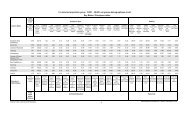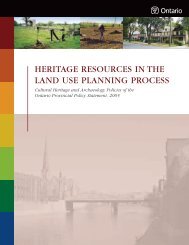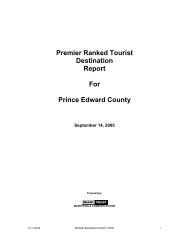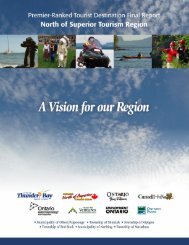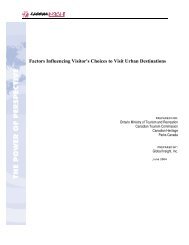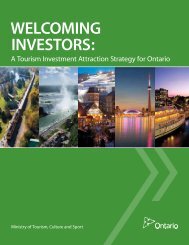Management Guidelines For Forestry and Resource-Based Tourism
Management Guidelines For Forestry and Resource-Based Tourism
Management Guidelines For Forestry and Resource-Based Tourism
- No tags were found...
Create successful ePaper yourself
Turn your PDF publications into a flip-book with our unique Google optimized e-Paper software.
<strong>Management</strong> <strong>Guidelines</strong> for <strong>For</strong>estry <strong>and</strong> <strong>Resource</strong>-<strong>Based</strong> <strong>Tourism</strong> – TOOLS AND TECHNIQUES3.5.2 Modifying Harvest Patterns To Avoid The“Manufactured Look”DescriptionHarvest patterns that resemble natural st<strong>and</strong>boundaries.Pros <strong>and</strong> Cons for the <strong>Resource</strong>-based <strong>Tourism</strong>IndustryPros• The aesthetics of harvest areas can be improved.Cons• NonePros <strong>and</strong> Cons for the <strong>For</strong>est IndustryPros• Protects resource-based tourism value whichmaintains good relationship with resource-basedtourism operatorsCons• Layout will be more costly• Potential for compliance industry3.5.3 Partial harvestDescriptionA portion of the forest is harvested at a particular timeso that when viewed from a resource-based tourismvalue the l<strong>and</strong>scape appears to be forested.Seed tree or shelterwood cuts in red <strong>and</strong> white pinecan also be effective.The shelterwood <strong>and</strong> selection harvest (silviculture) systemsrequire that only a portion of the forest beremoved during any particular harvest. These systemsare used in the Great Lakes St. Lawrence forest forthose species that have some tolerance for shade. Insome cases extra effort may be taken to address theneed to ensure view-scape protection.Pros <strong>and</strong> Cons for the <strong>Resource</strong>-based <strong>Tourism</strong>IndustryPros• Partial harvesting may be an effective strategy formaintaining a forested appearance in areas frequentlyviewed by tourists.Cons• Requires a forest operation adjacent to resourcebasedtourism values several times a rotation <strong>and</strong>constant revisits. This may limit the scope of roadstrategiesPros <strong>and</strong> Cons for the <strong>For</strong>est IndustryPros• May be an effective silvicultural strategyCons• Very costly for all concerned to remobilize severaltimes to return to the same area.• Potential loss of wood volume.• Since only a portion of the forest is harvested at anytime, harvesting of the forest will occur more frequently;every 15 to 20 years compared with every60 to 100 years when the clearcut system is used.Tip: when locating new outpost camps resourcebasedtourism business owners should consider futureTviews based on a forest management plan. Whilethere may be advantages to providing guests with abroad view of a lake by locating a camp up high oron a point the effort required to maintain such viewsmay be considerable.3.5.4 Early Green-UpDescriptionEfforts to establish a new forest may be enhanced byplanting trees early. Some sites may "green-up" muchmore rapidly than others.Where certain renewal systems such as corridorselection method apply, these systems may also help tore-establish a forested appearance on the l<strong>and</strong>scape.Tree planting <strong>and</strong> other regeneration practices are mostsuccessful during the spring.Sites may require preparation before planting <strong>and</strong> thereare scheduling considerations.Where intensive silvicultural systems apply, green-upwill be quicker.The inclusion of tertiary roads in site preparation <strong>and</strong>planting projects can blur their presence on the l<strong>and</strong>scapeimmediately <strong>and</strong> can help with access control.21



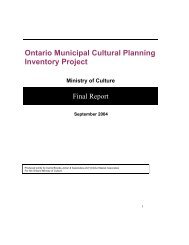
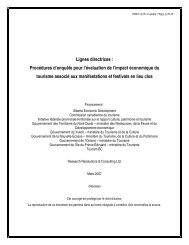
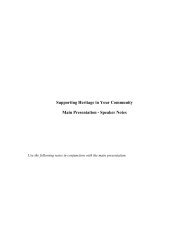
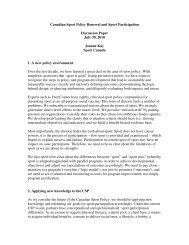
![THIS AGREEMENT made this [date], between [name of owner] (the ...](https://img.yumpu.com/49827605/1/158x260/this-agreement-made-this-date-between-name-of-owner-the-.jpg?quality=85)

